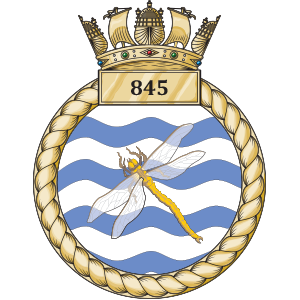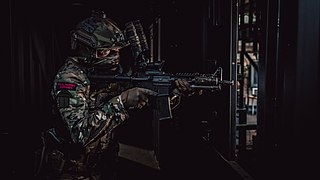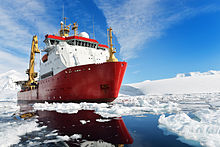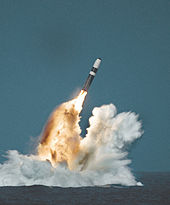
The Royal Navy (RN) is the naval warfare force of the United Kingdom, British Overseas Territories and Crown Dependencies, and a component of His Majesty's Naval Service. Although warships were used by English and Scottish kings from the early medieval period, the first major maritime engagements were fought in the Hundred Years' War against France. The modern Royal Navy traces its origins to the English Navy of the early 16th century; the oldest of the UK's armed services, it is consequently known as the Senior Service.

The Royal Fleet Auxiliary (RFA) is a naval auxiliary fleet owned by the UK's Ministry of Defence. It is a component of His Majesty's Naval Service and provides logistical and operational support to the Royal Navy and Royal Marines. The RFA ensures the Royal Navy is supplied and supported by providing fuel and stores through replenishment at sea, transporting Royal Marines and British Army personnel, providing medical care and transporting equipment and essentials around the world. In addition the RFA acts independently providing humanitarian aid, counter piracy and counter narcotic patrols together with assisting the Royal Navy in preventing conflict and securing international trade. They are a uniformed civilian branch of the Royal Navy staffed by British merchant sailors. The RFA is one of five RN fighting arms.

RFA Argus is a ship of the Royal Fleet Auxiliary operated by the Ministry of Defence under the Blue Ensign. Italian-built, Argus was formerly the container ship MVContender Bezant. The ship was requisitioned in 1982 for service in the Falklands War and purchased outright in 1984 for a four-year conversion to an Aviation Training Ship, replacing RFA Engadine. In 1991, during the Gulf War, she was fitted with an extensive and fully functional hospital to assume the additional role of Primary Casualty Receiving Ship. In 2009, the PCRS role became the ship's primary function. Argus is due to remain in service beyond 2030. In July 2022 it was reported that the future Littoral Strike Role would be assumed by Argus after a refit to convert her to this role. As of October 2023, Argus had started her deployment to serve as part of Littoral Response Group (South).

RFA Gold Rover(A271)was a Rover-class small fleet tanker of the Royal Fleet Auxiliary (RFA) and one of five ships that were designed by the Admiralty, all of which were built at the Swan Hunter shipyard.

The Armilla patrol was the name of the Royal Navy's permanent presence in the Persian Gulf during the 1980s and 1990s.

HMS Bulwark is the second ship of the Royal Navy's Albion-class assault ships. She is one of the United Kingdom's two landing platform docks designed to put Royal Marines ashore by air and by sea though is due to be retired by March 2025.

RFA Cardigan Bay is a Bay-class landing ship dock of the Royal Fleet Auxiliary (RFA). Built by BAE Systems, the ship was dedicated into the RFA at the end of 2006.

The Commander United Kingdom Strike Force is a senior post in the Royal Navy.

845 Naval Air Squadron is a squadron of the Royal Navy's Fleet Air Arm. Part of the Commando Helicopter Force, it is a specialist amphibious unit operating the AgustaWestland Commando Merlin HC4 helicopter and provides troop transport and load lifting support to the United Kingdom Commando Force and wider elements of the Royal Marines. In 2012, the squadron celebrated 50 years since it was awarded "commando" status.

HMS Duncan is the sixth and last of the Type 45 or Daring-class air-defence destroyers built for the Royal Navy and launched in 2010. Duncan is named after Adam Duncan, 1st Viscount Duncan, who defeated the Dutch fleet at the Battle of Camperdown on 11 October 1797. The destroyer has served in the Mediterranean, Black, and Caribbean Seas, and in 2019 was deployed to the Persian Gulf in response to increased tensions with Iran in the region. In May 2024, she deployed to the Red Sea to protect international shipping from the ongoing Houthi attacks.

HMS Pembroke was a Sandown-class minehunter of the Royal Navy (RN), the second ship launched from the class' second batch, with several improvements over the first five built.

HMS Brocklesby is a Hunt-class mine countermeasures vessel of the British Royal Navy, her primary purpose is to find and neutralise sea mines using a combination of; Sonar, Mine Clearance Divers and the Seafox remotely operated vehicle (ROV). The class are the largest warships of glass-reinforced plastic (GRP) construction, which gives the vessels a low magnetic signature. In addition to her mine countermeasures activities, Brocklesby acts as an offshore patrol vessel, undertaking coastal patrol and fisheries protection duties.

RFA Wave Knight is a Wave-class fast fleet tanker of the Royal Fleet Auxiliary (RFA) of the United Kingdom tasked with providing fuel, food, fresh water, ammunition and other supplies to Royal Navy vessels around the world.

The United Kingdom Naval Support Facility is a Royal Navy base established in Bahrain on 13 April 1935, as part of the port at Mina Salman. In 1950, the United States Navy leased space in HMS Jufair and following Bahraini independence in 1971, took over the base. On 6 December 2014, it was announced that HMS Jufair would be reestablished as a permanent Royal Navy base. On 5 April 2018, the UK Naval Support Facility was officially opened by the Crown Prince of Bahrain, Salman bin Hamad Al Khalifa and The Duke of York, representing the United Kingdom.

The Joint Expeditionary Force (Maritime) (or JEF(M)) (formerly the Response Force Task Group (RFTG), and prior to that the Joint Rapid Reaction Force (JRRF)), is the Royal Navy's contribution to the Joint Expeditionary Force (JEF) maintained at very high-readiness and available at short notice to respond to unexpected global events. In addition to the Royal Navy and the Royal Marines, the JEF(M) also includes elements of the British Army and the Royal Air Force. While it is primarily poised to conduct war-fighting or strike operations, the JEF(M) is capable of undertaking a diverse range of activities such as evacuation operations, disaster relief or humanitarian aid.

Exercise Joint Warrior is a major biannual multi-national military exercise which takes place in the United Kingdom, predominately in north west Scotland. It is the successor of the Neptune Warrior exercises and Joint Maritime Course.
In 1989 the Royal Navy was under the direction of the Navy Department in the UK Ministry of Defence. It had two main commands, CINCFLEET and Naval Home Command.
A Littoral Response Group (LRG) is a Royal Navy task group usually consisting of one or two amphibious warfare ships, a company of Royal Marines and supporting elements primarily tasked with littoral warfare from the littoral areas. They were first deployed in 2020 and have been described by the Royal Navy as being more flexible and agile compared to previous amphibious task groups with an emphasis on forward-basing, precision strike capabilities, high mobility, modern command and control technology, networked autonomous systems and deception capabilities. Multiple LRGs were to be able to combine to form a more substantial Littoral Strike Group (LSG) and also join a UK Carrier Strike Group to form an Expeditionary Strike Force.

The Future Commando Force (FCF) is an in-progress modernisation programme and transformation of the role and operations of the Royal Marines. The FCF essentially retasks 40 Commando and 45 Commando with forming two Littoral Response Groups (LRGs) which will be permanently deployed, though other units from UK Commando Force are also included in the composition of LRGs, as well as changing the role and operations of the Royal Marines and the equipment and tactics they use.

























